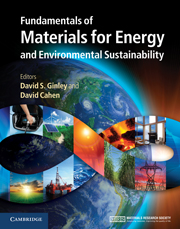Book contents
- Frontmatter
- Contents
- Contributors
- Preface
- Acknowledgments
- Part 1 Energy and the environment: the global landscape
- Part 2 Nonrenewable energy sources
- Part 3 Renewable energy sources
- Part 4 Transportation
- Part 5 Energy efficiency
- 35 Lighting
- 36 Energy efficient buildings
- 37 Insulation science
- 38 Industrial energy efficiency: a case study
- 39 Green processing: catalysis
- 40 Materials availability and recycling
- 41 Life-cycle assessment
- Part 6 Energy storage, high-penetration renewables, and grid stabilization
- Summary
- Appendix A Thermodynamics
- Appendix B Electrochemistry
- Appendix C Units
- Index
- References
36 - Energy efficient buildings
from Part 5 - Energy efficiency
Published online by Cambridge University Press: 05 June 2012
- Frontmatter
- Contents
- Contributors
- Preface
- Acknowledgments
- Part 1 Energy and the environment: the global landscape
- Part 2 Nonrenewable energy sources
- Part 3 Renewable energy sources
- Part 4 Transportation
- Part 5 Energy efficiency
- 35 Lighting
- 36 Energy efficient buildings
- 37 Insulation science
- 38 Industrial energy efficiency: a case study
- 39 Green processing: catalysis
- 40 Materials availability and recycling
- 41 Life-cycle assessment
- Part 6 Energy storage, high-penetration renewables, and grid stabilization
- Summary
- Appendix A Thermodynamics
- Appendix B Electrochemistry
- Appendix C Units
- Index
- References
Summary
Focus
Materials advances could help to reduce the energy and environmental impacts of buildings. Globally, buildings consume 30%–40% of primary energy and account for 25%–33% of CO2 emissions. Building energy consumption emanates from a variety of sources, some of which are related to the building envelope or fabric, some to the equipment in the building, and some to both. Opportunities for reducing energy use in buildings through the application of innovative materials are therefore numerous, but there is no one system, component, or material whose improvement can alone solve the building energy problem. Many of the loads in a building are interactive, and this complicates cost–benefit analysis for new materials, components, and systems. Moreover, components and materials for buildings must meet stringent durability and cost–performance criteria to last the long service lifetimes of buildings and compete successfully in the marketplace.
Synopsis
The world's buildings account for about one-third of greenhouse-gas emissions. The authors of a number of studies have concluded that one of the most cost-effective ways to reduce carbon emissions is to increase the energy efficiency of the existing building stock via energy retrofits, and to require a high degree of efficiency in new buildings. Several nations and states have even set goals requiring new buildings to have “zero net energy” consumption by established dates in the future. Some of the increases in efficiency can be achieved with currently available technology by using advanced building energy simulation and optimization techniques to establish technology packages that deliver maximum energy savings for minimal cost. The technology packages will vary by building type and climate type, and will also need to differ according to the level of development in various parts of the world. To realize further efficiency gains, new and better materials and technologies will be needed. This presents a unique opportunity and challenge for materials scientists. Success will depend not only on mastery of the usual disciplines associated with materials science, but also on a holistic understanding of the comfort, construction, and energy systems in buildings. This chapter explores some foundational concepts about how energy is used in buildings, and also highlights areas where materials-science advances would be most beneficial.
- Type
- Chapter
- Information
- Publisher: Cambridge University PressPrint publication year: 2011
References
- 2
- Cited by



